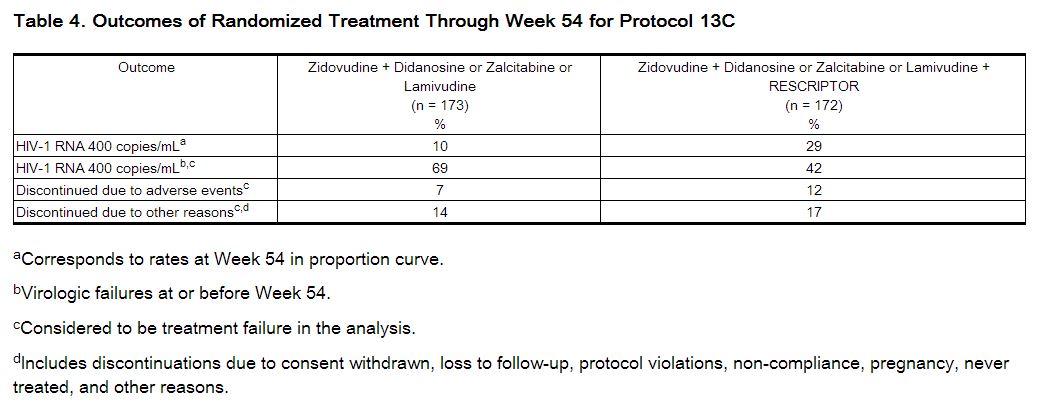Delavirdine clinical studies
Editor-In-Chief: C. Michael Gibson, M.S., M.D. [1]; Associate Editor(s)-in-Chief: Ahmed Zaghw, M.D. [2]
Clinical Studies
For clinical Studies 21 Part II and 13C described below, efficacy was evaluated by the percentage of patients with a plasma HIV-1 RNA level <400 copies/mL through Week 52 as measured by the Roche Amplicor® HIV-1 Monitor (standard assay). An intent-to-treat analysis was performed where only subjects who achieved confirmed suppression and sustained it through Week 52 are regarded as responders. All other subjects (including never suppressed, discontinued, and those who rebounded after initial suppression of <400 copies/mL) are considered failures at Week 52. Results of an interim analysis of efficacy conducted for studies 21 Part II and 13C by independent Data and Safety Monitoring Boards (DSMBs) revealed that the triple-therapy arms in both studies produced significantly greater antiviral benefit than the dual-therapy arms, and early termination of the studies was recommended.
Study 21 Part II
Study 21 Part II was a double‑blind, randomized, placebo‑controlled trial comparing treatment with RESCRIPTOR (400 mg 3 times daily, zidovudine 200 mg 3 times daily, and lamivudine 150 mg twice daily versus RESCRIPTOR 400 mg 3 times daily and zidovudine 200 mg 3 times daily versus zidovudine 200 mg 3 times daily and lamivudine 150 mg twice daily in 373 HIV-1–infected patients (mean age 35 years [range: 17 to 67], 87% male, and 60% Caucasian) who were antiretroviral treatment naive (84%) or had limited nucleoside experience (16%). Mean baseline CD4+ cell count was 359 cells/mm3 and mean baseline plasma HIV‑1 RNA was 4.4 log10 copies/mL.
Results showed that the mean increases from baseline in CD4 cell counts at 52 weeks were 111 cells/mL for RESCRIPTOR + zidovudine + lamivudine, 27 cells/mL for RESCRIPTOR + zidovudine, and 74 cells/mL for zidovudine + lamivudine.
The results of the intent-to-treat analysis of the percentage of patients with a plasma HIV-1 RNA level <400 copies/mL are presented in Figure 1. HIV-1 RNA status and reasons for discontinuation of randomized treatment at 52 weeks are summarized in Table 3. Subjects who were never suppressed before discontinuation were placed in the discontinuation category.
Figure 1. Percentage of Patients With HIV-1 RNA Below 400 copies/mL Standard PCR Assay Protocol 21 Part II: Intent-to–Treat Analysis
 |
 |
Study 13C
Study 13C was a double‑blind, randomized, placebo‑controlled trial comparing treatment with RESCRIPTOR 400 mg 3 times daily, zidovudine 200 mg 3 times daily or 300 mg twice daily, and either didanosine 200 mg twice daily, zalcitabine 0.75 mg 3 times daily, or lamivudine 150 mg twice daily versus zidovudine 200 mg 3 times daily or 300 mg twice daily and either didanosine 200 mg twice daily, zalcitabine 0.75 mg 3 times daily, or lamivudine 150 mg twice daily in 345 HIV-1–infected patients (mean age 35.8 years [range: 18 to 72], 66% male, and 63% Caucasian) who were antiretroviral treatment naive (63%) or had limited antiretroviral experience (37%). Mean baseline CD4+ cell count was 210 cells/mm3 and mean baseline plasma HIV‑1 RNA was 4.9 log10 copies/mL.
Results showed that the mean increases from baseline in CD4+ cell counts at 54 weeks were 102 cells/mL for RESCRIPTOR + zidovudine + didanosine or zalcitabine or lamivudine, and 56 cells/mL for zidovudine + didanosine or zalcitabine or lamivudine.
The results of the intent‑to‑treat analysis of the percentage of patients with a plasma HIV‑1 RNA level 400 copies/mL are presented in Figure 2. HIV‑1 RNA status and reasons for discontinuation of randomized treatment at 54 weeks are summarized in Table 4. Subjects who were never suppressed before discontinuation were placed in the discontinuation category.
Figure 2. Percentage of Patients With HIV-1 RNA Below 400 copies/mL Standard PCR Assay Protocol 13C: Intent-to–Treat Analysis
 |
 |
Results from several smaller supportive studies evaluating the use of RESCRIPTOR in treatment-naive patients suggest that it may have activity when used in combination with protease inhibitors and NRTIs in 3- or 4-drug combinations.[1]
References
Adapted from the FDA Package Insert.